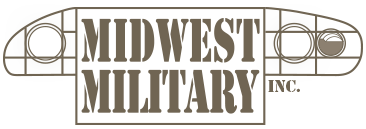The following narrative was written by Mr. Paul Viens, founder of TM9 Ordnance Products:
The beginning of my journey started when I bought a 1944 WC-51 in the late summer of 2004. It was well worn cosmetically, yet mechanically well cared for and maintained. The paint was faded, chipped, and in need of some freshening up.
Considering that thousands of military vehicles were manufactured during the Second World War, I never thought it would be so hard to nail down a shade of U.S. Army Olive Drab to my satisfaction.
As all of you can relate, I have spent many hours replacing rotted, bent and broken parts. I have sandblasted, stripped and sanded. I’ve used two part epoxy primer that dries almost as hard as a grade 8 bolt, and used many coats of sandable primer to get ready for paint. That’s where I came to a sudden stop
I wanted a hard and durable FLAT finish, but not really possible from what products I was aware of at this time. By hard and durable I mean catalyst activated. No matter what paint I end up with, I know that it will be a single stage product. At this point I find out that most of the commercially available products are single part enamels.It would be nice to have a flat clear coat on top of the main color since this would prevent oil and grease spots from leaving their marks, but then the stains and marks help contribute to what makes a Military Vehicle what it is, an active working tool.
Well after months of working on the Dodge truck I really want to get it rolling. I’ve got parts everywhere. You have all been there. Fenders hanging from the garage ceiling, body parts in the basement and under the deck. Parts coming at least once a week from all of the vendors we know and stuff I can find on the internet.
Finally, I decide to make my own paint. I get every NOS part I can buy, find and borrow to start the process. I started with a green catalyst activated industrial paint and spent about 60 hours mixing and recording my progress. Never big batches, but a vast amount of small samples. Finally I get something I like that matches pretty close to my parts. This shade is ultimately named Lustreless Olive Drab Shade #4. I realize that all of the parts were slightly different in hue. I expected this since the parts all have different pedigrees. Some of the original boxes and tags are dated in the early 1950’s. Were these parts made in the 1950’s or repackaged parts made earlier? I have no idea. However, they are tagged for WWII era vehicles. Some of the parts are in original boxes that are still sealed, some in canvas, and some in opened boxes. At the end of the day I have what I would consider to be three different shades of Lustreless Olive Drab. Lustreless Olive Drab Shade #2 was a common hue on four original metal rifle scabbards and a number of NOS electrical parts such as switches and light housings. Lustreless Olive Drab Shade #6 is from an original MP50 bracket and a host of small parts with packaging from the early 1950’s. Coincidentally, Shade #6 is close, but not exactly the same as the typical US Army Signal Corps OD seen on radios, transformers, etc.
Were there three different shades of Lustreless Olive Drab made in the 1940’s? Somehow I doubt it, but that’s what I was faced with.
Well after getting one sample I really like, (Shade #4), I send it off to an industrial paint manufacturer to see if they can match the color and hue. After about three weeks a spray card comes back with a gallon of paint. I’m off to the races! Well once the catalyst is added at the required 5 to 1 ratio, the paint begins to gloss up. No surprise. Is it acceptable? Well it is not gloss, and even flatter than semi-gloss. More like a sheen. But at this point I really want this to be as close to Lustreless as a catalyst paint will allow.
After a long conversation with the R&D department we all agree how to approach this issue. Portions of this conversation include: What type of flatteners are used today versus the 1940’s and that if I was looking to really get an accurate paint it would be very rough in texture, wear relatively fast, and not be catalyst activated.
But at this point my focus is on:
- Shades of Olive Drab based on what parts I have,
- In a time frame that the weather would allow me to still paint my truck, and
- A urethane based paint that would remain durable.
By no means am I a paint expert, but from the paint company’s R&D view point, this is analogous to a simultaneous equation, with a number of variables, and the solution to this problem, is not free. Just adding powdered flattener will not solve the problem. So I stepped up to the plate and paid. They in turn, solved the problem to my satisfaction.


